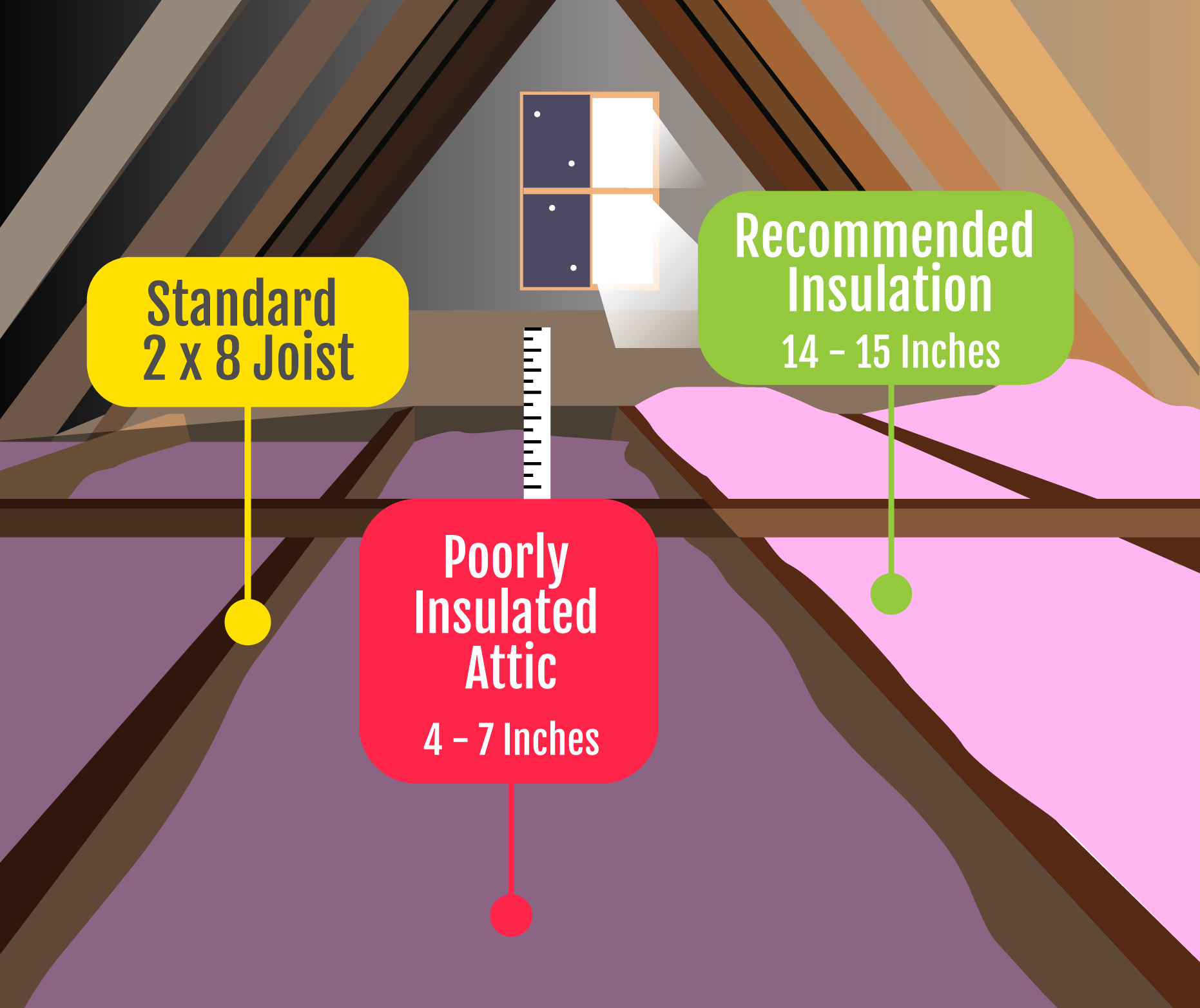What Is R-Value & Why It Matters to MI Residents|Koala Insulation

What Is R-Value And Why It Matters
Home insulation is a must in a region with warm summers and chilly winters. For instance, take a look at Michigan. The temperatures in Michigan vary from 17 °F to 82 °F throughout the year.
Such US states are prone to a considerable loss in energy efficiency. In these cases, the R-value, i.e., the resistance to heat flow, can help your HVAC systems run efficiently.
In simple words, before choosing an insulating material, it’s vital to have basic info about R-value. Consequently, you can maximize your savings and experience the benefits of a cozy home, ready to tackle any weather.
This blog intends to inform you about R-value, its codes, and how improper insulation can impact your budget.
The Basics of R-value
Why does R-value matter?
Recall the interesting science classes. You might have learned this concept – heat moves from warm to cool spaces.
You don’t need to scratch your heads thinking about convection, conduction, and radiation. Simply understand the following phenomena.
- In summers, hot air tries to enter your air-conditioned interior
- During winters, warm air escapes through the windows
Amidst this natural process, your HVAC systems need to work hard to maintain the optimum indoor temperature.
The adverse effect? High utility costs.
R-value Definition and Explanation
In simple words, R-value is the ability of an insulation to resist heat flow. This term is directly proportional to insulating effectiveness.
R-value is generally measured as a specific number. It is essential to realize that the R-value will vary as per your indoor space. Typically, insulation contractors calculate this value for the following areas.
- Attic
- Floor
- Wall
- Ceiling
- Windows
Depending on the climate zone, thickness, and type of material, the R-value can change. An experienced insulation contractor will suggest the proper requirement for the same.
Typical Insulating Materials
Each insulating material has a different R-value. Hence, a little knowledge of the commonly used materials is benign.
Here’s a list of materials that contractors use for indoor home insulation.
- Fiberglass
- Silica aerogel
- Spray foam
- Polyethylene foam
- Insulated glass
You can refer to the US Department of Energy guide for R-values of such insulating materials.
The US R-value Chart
The United States has regions that differ in terms of climate and temperature. The Department of Energy has specified zones for various states.
This chart gives a general idea about the ideal R-value of your place of residence.
Table: R-values US Zones (US Dept. of Energy)
|
Zone |
Attic (Uninsulated) |
Floor (Uninsulated) |
Wall (Uninsulated) |
|
1 |
R30 – R49 |
R13 |
Blow insulation in an empty wall cavity |
|
2 |
R30 – R60 |
R13 – R19 |
|
|
3 |
R30 – R60 |
R19 – R25 |
Blow insulation in an empty wall cavity and add R5 wall sheathing beneath the new siding |
|
4 |
R38 – R60 |
R25 – R30 |
|
|
5 |
R49 – R60 |
Blow insulation in an empty wall cavity and add R5/R6 wall sheathing beneath the new siding |
|
|
6 |
|||
|
7 |
|||
|
8 |
If you live in Midland, Freeland, Saginaw, or Bay City, refer to the corresponding climate zones. The Michigan state lies in zones 5 to 7.
However, the above chart shows the recommended R-values for uninsulated spaces. The values change considerably if you already have existing insulation of around three to four inches.
Impact of Inconsistent Insulation
As you cannot stop heat flow, it’s important to slow it down with proper insulation. Otherwise, you can face detrimental effects as follows.
- Increase in humidity
- A rise in energy bills
- Load on HVAC systems
- Draft problems
- Stack effect
- Chances of air leakage
- Presence of air contaminants
Citizens living in a state like Michigan should never overlook the value of insulating their homes properly. The extensive range of temperature differences can cause challenges in maintaining proper heat management.
R-value for Michigan Homeowners
The Michigan Energy Code consists of in-depth air barrier and insulation guidelines that every citizen must know. However, for the sake of simplification, this table gives a clear-cut idea about the R-value range you should consider.
Table: Suggested R-values for Michigan State
|
Space |
Uninsulated |
Existing insulation (~ 3 – 4 inches) |
|
Attic |
R49 – R 60 |
R38 – R49 |
|
Floor |
R25 – R30 |
|
Whether you live in Frankenmuth or Saginaw, the Koala Insulation of Mid-Michigan can suggest the best materials and techniques.
Based in Midland, Michigan, these insulator contractors have an in-depth understating of R-value and its practical application.
Endnotes
A suitable material like Spray foam or fiberglass can reduce your energy costs considerably. Existing or new homes need to combat the climate change effects efficiently.
Thus, it’s crucial to choose insulation with the correct R-value. This term is subjective and depends on various parameters. Hence, you can contact expert contractors like Koala Insulation of Mid-Michigan and avoid those chilly evenings during winters.
Home insulation is a must in a region with warm summers and chilly winters. For instance, take a look at Michigan. The temperatures in Michigan vary from 17 °F to 82 °F throughout the year.
Such US states are prone to a considerable loss in energy efficiency. In these cases, the R-value, i.e., the resistance to heat flow, can help your HVAC systems run efficiently.
In simple words, before choosing an insulating material, it’s vital to have basic info about R-value. Consequently, you can maximize your savings and experience the benefits of a cozy home, ready to tackle any weather.
This blog intends to inform you about R-value, its codes, and how improper insulation can impact your budget.
The Basics of R-value
Why does R-value matter?
Recall the interesting science classes. You might have learned this concept – heat moves from warm to cool spaces.
You don’t need to scratch your heads thinking about convection, conduction, and radiation. Simply understand the following phenomena.
- In summers, hot air tries to enter your air-conditioned interior
- During winters, warm air escapes through the windows
Amidst this natural process, your HVAC systems need to work hard to maintain the optimum indoor temperature.
The adverse effect? High utility costs.
R-value Definition and Explanation
In simple words, R-value is the ability of an insulation to resist heat flow. This term is directly proportional to insulating effectiveness.
R-value is generally measured as a specific number. It is essential to realize that the R-value will vary as per your indoor space. Typically, insulation contractors calculate this value for the following areas.
- Attic
- Floor
- Wall
- Ceiling
- Windows
Depending on the climate zone, thickness, and type of material, the R-value can change. An experienced insulation contractor will suggest the proper requirement for the same.
Typical Insulating Materials
Each insulating material has a different R-value. Hence, a little knowledge of the commonly used materials is benign.
Here’s a list of materials that contractors use for indoor home insulation.
- Fiberglass
- Silica aerogel
- Spray foam
- Polyethylene foam
- Insulated glass
You can refer to the US Department of Energy guide for R-values of such insulating materials.
The US R-value Chart
The United States has regions that differ in terms of climate and temperature. The Department of Energy has specified zones for various states.
This chart gives a general idea about the ideal R-value of your place of residence.
Table: R-values US Zones (US Dept. of Energy)
|
Zone |
Attic (Uninsulated) |
Floor (Uninsulated) |
Wall (Uninsulated) |
|
1 |
R30 – R49 |
R13 |
Blow insulation in an empty wall cavity |
|
2 |
R30 – R60 |
R13 – R19 |
|
|
3 |
R30 – R60 |
R19 – R25 |
Blow insulation in an empty wall cavity and add R5 wall sheathing beneath the new siding |
|
4 |
R38 – R60 |
R25 – R30 |
|
|
5 |
R49 – R60 |
Blow insulation in an empty wall cavity and add R5/R6 wall sheathing beneath the new siding |
|
|
6 |
|||
|
7 |
|||
|
8 |
If you live in Midland, Freeland, Flint, Saginaw, Mt Pleasant, Frankenmuth, Birth Run, Swartz Creek, Brandon Twp, Grand Blanc, Fenton, Clio, Lapeer, Essexville, Bay City or any other Mid-Michigan town refer to the corresponding climate zones. The Michigan state lies in zones 5 to 7.
However, the above chart shows the recommended R-values for uninsulated spaces. The values change considerably if you already have existing insulation of around three to four inches.
Impact of Inconsistent Insulation
As you cannot stop heat flow, it’s important to slow it down with proper insulation. Otherwise, you can face detrimental effects as follows.
- Increase in humidity
- A rise in energy bills
- Load on HVAC systems
- Draft problems
- Stack effect
- Chances of air leakage
- Presence of air contaminants
Citizens living in a state like Michigan should never overlook the value of insulating their homes properly. The extensive range of temperature differences can cause challenges in maintaining proper heat management.
R-value for Michigan Homeowners
The Michigan Energy Code consists of in-depth air barrier and insulation guidelines that every citizen must know. However, for the sake of simplification, this table gives a clear-cut idea about the R-value range you should consider.
Table: Suggested R-values for Michigan State
|
Space |
Uninsulated |
Existing insulation (~ 3 – 4 inches) |
|
Attic |
R49 – R 60 |
R38 – R49 |
|
Floor |
R25 – R30 |
|
Whether you live in Frankenmuth, Midland, Freeland, Flint, Saginaw, Mt Pleasant, Frankenmuth, Birth Run, Swartz Creek, Brandon Twp, Grand Blanc, Fenton, Clio, Lapeer, Essexville or Bay City, Koala Insulation of Mid-Michigan can suggest the best materials and techniques.
Endnotes
A suitable material like Spray foam or fiberglass can reduce your energy costs considerably. Existing or new homes need to combat the climate change effects efficiently.
Thus, it’s crucial to choose insulation with the correct R-value. This term is subjective and depends on various parameters. Hence, you can contact expert contractors like Koala Insulation of Mid-Michigan and avoid those chilly evenings during winters.
Find Your Location


Get a quote



